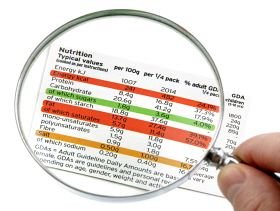There are more than 350 food additives approved for use in Australia. They appear in everything from cake mix to taco seasoning and more than likely can be found in food items that you least expect. Have you ever wondered how safe these extra ingredients are to eat?
Whilst these additives are all approved by Food Standards Australia and New Zealand, there is evidence to suggest that some may in fact be harmful to you and your family.
Even if you think you can read food labels, that don’t always tell the full story. Clever loopholes in legislation and the labelling system allow companies to avoid having to list all the chemicals they use to produce our food. This permits companies to either omit additives from the ingredient list completely or list it under a generic, less alarming name.
Today I want to arm you with the information you need to read labels properly and to make informed choices while shopping for your family.
Unfortunately, there is no easy way to spot an additive – they go by both names and numbers so you need to be aware and conscious of what to look out for.
- Artificial Colours
Colours are distinguished by the 100 range of numbers. The additives are used to add or restore colour to foods make foods appear more appealing and appetizing. Think of sugary cereals or flavoured chips, they often appear so vibrant and perfect in colour. The worst offenders:
- Tartrazine (102) – can induce hives and asthma
- Allura red (129) – linked to hyperactivity
- Ponceau 4R also known as Cochineal Red (124, E124) – linked to hyperactivity, banned in the USA for links to cancer
- Preservatives
Preservatives protect food against deterioration and improve the shelf-life. They are identifiable by the 200 number range and have been linked with intolerances, particularly in people with asthma. Look out for:
- Sorbates – commonly used in fruit sauces, drinks, baked goods, cured meats, yoghurts as well as home care products plus so much more. Sorbates are linked to migraines and hypersensitivity reactions like itching of the eyes, throat, mouth and skin, runny nose and congestion
- Sulfites – used in wine and dried fruits. These can trigger wheezing, throat tightening and coughing and can lead to the degradation of B vitamins
- Benzoates – commonly added to soft drinks, cordials and fruit drinks. Benzoates may trigger allergic reactions and have also been linked to hypersensitivity
- Propionates – added to breads, cakes and pastries to inhibit mould growth. Propionates are linked to hyperactivity in children. Calcium propionate can cause behavioural changes like irritability, restlessness, inattention and sleep disturbances
- Nitrates – used in processed meats and has been classified as a probable carcinogen to humans by the World Health Organisation’s International Agency for Research for Cancer
- Antioxidants
Antioxidants appear in the 300 number range and are used to prevent or slow down oxidative deterioration of foods. A perfect example is fresh salmon, have you ever noticed how vibrant the colour of salmon is when you purchase it? Untreated the vibrancy of this fleshy red colour would oxidise to a dark brown but with the help of antioxidants, the fish appears as if it was caught fresh off the coast that very same morning. Now the term antioxidants is misleading because as a general rule we assume all antioxidants are health promoting, but this isn’t necessarily true. Yes, antioxidants found in wholefoods (eg: vitamin C found in strawberries) are powerful nutrients that reduce oxidative stress and promote hundreds of helpful physiological functions in the body, this is because they work synergistically with other nutrients and polyphenols found in that food. Selective antioxidant additives however, do not benefit the body the same way.
- Butylated hydroxyanisole aka BHA (320) – is found in margarine and spreads, cereals, gum, potato chips and oils. It’s listed as probable carcinogen to humans by the World Health Organisations’ International Agency for Research for Cancer, but is still among the commonly-used preservatives in packaged foods.
- Artificial Sweeteners
Artificial sweeteners appear in the 900 and 420 number range. They give products sweetness without raising blood glucose levels and without less kilojoules than regular sugar. They were once touted as the answer to eliminating sugar from our diets but we now know the many health implications of eating these additives. Some of the worst include:
- Aspartame (951) – commonly found in diet (low sugar, low fat) foods and soft drinks, it can be found or rather hidden behind names like Nutrasweet and Equal. A 2007 study found feeding rats aspartame increased risk of leukemia, lymphoma and breast cancer. Aspartame has also been associated with migraines, weight gain, insomnia, depression, anxiety, rashes, heart palpitations and even Multiple Sclerosis.
- Acesultamine-K aka Acesulfame Potassium (950) – a chemical sweetener found in Diet Coke and Coke Zero, it contains methylene chloride – a known carcinogen.
- Cyclamate (952) – Cyclamate has been banned in Canada, the UK and USA for many years due to links to cancer, it is however, still approved for use in Australia.
- Flavour Enhancers
Arguably the most well-known of alarming food additives are the flavour enhancers found in the 600 number range. As the name suggests flavour enhancers make foods hard to resist by triggering a neurological response that keeps us coming back for more.
- Mono-sodium glutamate aka MSG (621) – found in Asian cuisine and added to soups, stocks, sauces, instant noodles, chips and snack foods. Often disguised under many names; glutamic acid, yeast extract, hydrolysed protein, natural flavour or umami. MSG is often associated with a collection of symptoms including headaches, numbness and tingling. Regular consumption has been linked to obesity, eye damage, headaches, fatigue, disorientation, depression and so much more!
- High fructose corn syrup and cane sugar
We often hear a lot about high fructose corn syrup (HFCS) which is added to every single processed food in the United States. And we mean, everything! There are 80 million acres in the United States dedicated to the production of corn as the addiction to this additive is so ingrained in the culture. In Australia we don’t use HFCS, instead we rely on sugarcane as our crop of choice and readily add this to most of our processed foods as our addiction to sugar is almost as strong.
HFCS is made up of 55% fructose, 45% glucose, while cane sugar is 50% fructose, 50% glucose – and they function in the exact same way, to make food sweeter. In Australia, sugar as an additive can be listed as one of over 50 different names, which is a clever way to disguise it if you are only looking for the word ‘sugar’ in the ingredients list. HFCS and cane sugar raise blood glucose and insulin levels causing energy to spike and then crash. Additionally, due to the high fructose content of these additives they metabolise to fat more rapidly than other sugars, they raise triglycerides impacting cholesterol levels and causing weight gain.
- Trans Fats
Trans fats are a by-product of hydrogenation, a process used to turn healthy oils into solids and to prevent rancidity. They were officially banned from all foods in the USA in May 2019 as research had shown they were no longer considered safe for consumption. Unfortunately, there are still present in packaged and processed foods in Australia and alarmingly are not required to be included on a nutritional label unless the manufacturer has made a claim relating to cholesterol or other fats.
Trans fats are commonly found in deep fried foods, commercial cakes and pastries, canned soups, cake mixes, crackers and snack foods, margarine, dips, frozen foods and popcorn. Trans fats are a major risk factor for coronary heart disease, they increase the low-density lipoprotein (LDL’s) cholesterol in the blood, also known as bad cholesterol and decrease the good cholesterol, high-density lipoproteins (HDL).
The 5% loophole
Earlier I mentioned clever loopholes that allow companies to mislead consumers with their labelling. The 5% loophole means that if an additive is equivalent to less then 5% of the total ingredients, it does not need to be listed. For example; “Chicken Flavour” tactfully disguises MSG as an ingredient in some snack products.
Armed with this information you needn’t be nervous, you should feel empowered. You don’t need to learn these chemical names and complex numbers by heart, set yourself simple guidelines when navigating through food additives:
- Remember wholefood is best, steer clear of processed foods where possible
- If it contains a number in the ingredient list, it’s probably not worth eating
- If it contains more than five ingredients OR you can’t pronounce an ingredient, put it down
- If it looks highly processed, assumed its full of additives
For more information on food additives, we recommend these resources:
The book The Chemical Maze by Bill Statham
Website: Food Intolerance Network – providing independent information about the effects of food on behaviour, health and learning
Website: Food Standards Australia and New Zealand – for a full list of additives by alphabetical names and numeric identification.
If you have any more questions, you can call us to book a FREE 15 minute chat with one of our Naturopaths to see how we can help you. Call now on (02) 4961 4075.
Peter
Is your kid always sick? Do you suspect he/she has a food intolerance? Difficulty concentrating? Gut problems?





